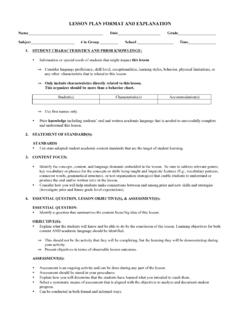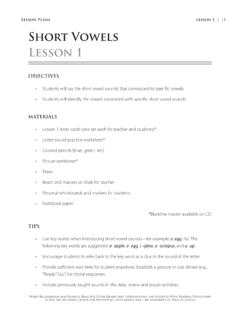Transcription of Lesson Plan for grade 2 math lesson- EW
1 Lesson plan Teacher: Mrs. Gerhart/Mrs. Creamer Class/Subject: Second grade /Mathematics Date: March 14, 2012 Domain: Operations and Algebraic Thinking Cluster: Represent and solve problems involving addition and subtraction. Standards: Use addition and subtraction within 100 to solve one- and two-step word problems involving situations of adding to, taking from, putting together, taking apart, and comparing, with unknowns in all positions, , by using drawings and equations with a symbol for the unknown number to represent the problem. Embedded Mathematical Practices: 1.
2 Make sense of problems and persevere in solving them, 3. Construct viable arguments and critique the reasoning of others, 4. Model with mathematics, 8. Look for and express regularity in repeated reasoning Learning Targets: Kid-Friendly Language Students will: identify the unknown in an addition or subtraction word problem (Knowledge) write an addition and subtraction equation with a symbol for the unknown (Knowledge) Use drawings or equations to represent one- and two-step word problems (Reasoning) Add and subtract within 100 to solve one-step word problems with unknowns in all positions (Reasoning) Add and subtract within 100 to solve two-step word problems with unknowns in all positions (Reasoning)
3 Determine operation needed to solve addition and subtraction problems in situations including add to, take from, put together, take apart, and compare (Reasoning) Materials/Resources: Large supply of connecting (unifix) cubes for testing various solutions or Manipulatives such as pompoms, yarn, tooth picks, or other materials that students could use to represent head, tails, and legs, pictures or books about farm animals Paper & Pencils to record solution/ answers, results Evidence Trackers to record mathematical conversations/dialogue and track learning Poster of Rules for problem What I saw at the farm listed on chart paper Chart paper to brainstorm group work- Looks Like/Sounds Like?
4 (10 minutes) Introduction/ Critical Input Experience: Talk about visiting my friends farm. Discuss what group work looks and sounds that we all can do our best problem solving and thinking. (25 minutes) Procedures: 1. Present problem: The other day, I was visiting my friend and she lives on a farm. We went out to see the animals that she has and this is what I 4 heads 10 legs 3 tails What animals did I see? 2. You will be working with a small group to problem solve a solution for the situation. You may use cubes, or other manipulatives that you think will help you reach a solution.
5 You will need to draw a picture of your solution and write about it. 3. Send children out w/ materials; pencil, paper 4. Set up other adults w/ evidence trackers- Explain importance of not giving students help- let them struggle/ do not guide. May ask question- Please tell me what you are thinking? RECORD response please. 5. Allow students to work (15 minutes) The children will use diagrams and/or manipulatives to guess and check for correct 6. solutions. (Some students will be able to label their work with numerical phrases.) 7. Bring students back together and take time for partners to share-out results and thinking.
6 Did we all have the same thinking/answers? (20 minutes) (Extensions) Have students write about how they helped to solve the problem and what they discovered by listening to their classmates sharing. Wrap Up/Reflection (Student (s): Use questioning: How would you explain your choices? How do you know that your reasoning is on track? Evidence of Learning/Assessment: Reflect on notes recorded on evidence trackers Refer to rubric Reflection/Comments (Teacher (s): Does student show understanding parameters of problem? Did students realize that there were multiple solutions to the problem?))
7 (Two or more solutions are given to the problem) Evidence of how did students apply mathematical practices- Communication & use of mathematical language








